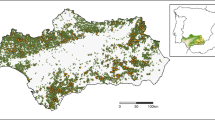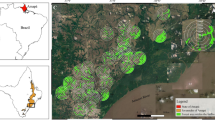Abstract
Species assemblages are shaped by local and continental-scale processes that are seldom investigated together, due to the lack of surveys along independent gradients of latitude and habitat types. Our study investigated changes in the effects of forest composition and structure on bat and bird diversity across Europe. We compared the taxonomic and functional diversity of bat and bird assemblages in 209 mature forest plots spread along gradients of forest composition and vertical structure, replicated in 6 regions spanning from the Mediterranean to the boreal biomes. Species richness and functional evenness of both bat and bird communities were affected by the interactions between latitude and forest composition and structure. Bat and bird species richness increased with broadleaved tree cover in temperate and especially in boreal regions but not in the Mediterranean where they increased with conifer abundance. Bat species richness was lower in forests with smaller trees and denser understorey only in northern regions. Bird species richness was not affected by forest structure. Bird functional evenness increased in younger and denser forests. Bat functional evenness was also influenced by interactions between latitude and understorey structure, increasing in temperate forests but decreasing in the Mediterranean. Covariation between bat and bird abundances also shifted across Europe, from negative in southern forests to positive in northern forests. Our results suggest that community assembly processes in bats and birds of European forests are predominantly driven by abundance and accessibility of feeding resources, i.e., insect prey, and their changes across both forest types and latitudes.




Similar content being viewed by others
References
Ampoorter E, Baeten L, Koricheva J, Vanhellemont M, Verheyen K (2014) Do diverse overstoreys induce diverse understoreys? Lessons learnt from an experimental-observational platform in Finland. For Ecol Manag 318:206–215
Baeten L, Verheyen K, Wirth C, Bruelheide H, Bussotti F, Finér L, Jaroszewicz B, Selvi F, Valladares F, Allan E, Ampoorter E, Auge H, Avăcăriei D, Barbaro L, Bărnoaiea I, Bastias C, Bauhus J, Beinhoff C, Benavides R, Benneter A, Berger S, Berthold F, Boberg J, Bonal D et al (2013) A novel comparative research platform designed to determine the functional significance of tree species diversity in European forests. Perspect Plant Ecol Evol Syst 15:281–291
Barbaro L, Giffard B, Charbonnier Y, van Halder I, Brockerhoff EG (2014) Bird functional diversity enhances insectivory at forest edges: a transcontinental experiment. Divers Distrib 20:149–159
Bates D, Maechler M, Bolker B, Walker S (2015) Fitting linear mixed-effects models using lme4. J Stat Softw 67(1):1–48. doi:10.18637/jss.v067.i01
Berger-Tal O, Berger-Tal R, Korine C, Holderied MW, Fenton MB (2008) Echolocation calls produced by Kuhl’s pipistrelles in different flight situations. J Zool 274:59–64
Björkman C, Larsson S (1991) Pine sawfly defence and variation in host plant resin acids: a trade-off with growth. Ecol Entomol 16:283–289
Bonthoux S, Balent G (2012) Point count duration: 5 minutes are sufficient to model the distribution of bird species and study the structure of communities in a French landscape. J Ornithol 153:491–504
Brändle M, Brandl R (2001) Species richness of insects and mites on trees: expanding Southwood. J Anim Ecol 70:491–504
Charbonnier Y, Gaüzère P, van Halder I, Nezan J, Barnagaud JY, Jactel H, Barbaro L (2016) Deciduous trees increase bat diversity at stand and landscape scales in mosaic pine plantations. Land Ecol 31:291–300
Cisneros LM, Fagan ME, Willig MR (2015) Effects of human-modified landscapes on taxonomic, functional, and phylogenetic dimensions of bat biodiversity. Divers Distrib 21:523–533
Clarke A, Gaston KJ (2006) Climate, energy and diversity. Proc R Soc B Biol Sci 273:2257–2266
Cruz J, Sarmento P, Rydevik G, Rebelo H, White PCL (2016) Bats like vintage: managing exotic eucalypt plantations for bat conservation in a Mediterranean landscape. Anim Conserv 19:53–64
Dietz C, von Helversen O, Nill D (2009) Bats of Britain. A & C Black, Europe and Northwest Africa
Duchamp JE, Swihart RK (2008) Shifts in bat community structure related to evolved traits and features of human-altered landscapes. Landsc Ecol 23:849–860
Eglington SM, Brereton TM, Tayleur CM, Noble D, Risely K, Roy DB, Pearce-Higgins JW (2015) Patterns and causes of covariation in bird and butterfly community structure. Landsc Ecol 30:1461–1472
Evans KL, Warren PH, Gaston KJ (2005) Species-energy relationships at the macroecological scale: a review of the mechanisms. Biol Rev 80:1–25
Ferger SW, Schleuning M, Hemp A, Howell KM, Böhning-Gaese K (2014) Food resources and vegetation structure mediate climatic effects on species richness of birds. Glob Ecol Biogeogr 23:541–549
Fuentes-Montemayor E, Goulson D, Cavin L, Wallace JM, Park KJ (2013) Fragmented woodlands in agricultural landscapes: the influence of woodland character and landscape context on bats and their insect prey. Agric Ecosyst Environ 172:6–15
Giffard B, Corcket E, Barbaro L, Jactel H (2012) Bird predation enhances tree seedling resistance to insect herbivores in contrasting forest habitats. Oecologia 168:415–424
Hanspach J, Fischer J, Ikin K, Stott J, Law BS (2012) Using trait-based filtering as a predictive framework for conservation: a case study of bats on farms in southeastern Australia. J Appl Ecol 49:842–850
Hillebrand H, Bennett DM, Cadotte MW (2008) Consequences of dominance: a review of evenness effects on local and regional ecosystem processes. Ecology 89:1510–1520
Huntley B, Green RE, Collingham YC, Willis SG (2007) A climatic atlas of European breeding birds. Lynx, Barcelona
Hurlbert AH (2004) Species-energy relationships and habitat complexity in bird communities. Ecol Lett 7:714–720
Ikin K, Barton PS, Stirnemann I, Stein JR, Michael D, Crane M, Okada S, Lindenmayer DB (2014) Multi-scale associations between vegetation cover and woodland bird communities across a large agricultural region. Plos One 9:e97029
Jung K, Kaiser S, Böhm S, Nieschulze J, Kalko EKV (2012) Moving in three dimensions: effects of structural complexity on occurrence and activity of insectivorous bats in managed forest stands. J Appl Ecol 49:523–531
Kalko EK, Schnitzler HU (1993) Plasticity in echolocation signals of European pipistrelle bats in search flight: implications for habitat use and prey detection. Behav Ecol Sociobiol 33:415–428
Kissling WD, Sekercioglu CH, Jetz W (2012) Bird dietary guild richness across latitudes, environments and biogeographic regions. Glob Ecol Biogeogr 21:328–340
Klingbeil BT, Willig MR (2015) Bird biodiversity assessments in temperate forest: the value of point count versus acoustic monitoring protocols. Peer J 3:e973
Kozlov MV, Stańska M, Hajdamowicz I, Zverev V, Zvereva EL (2015a) Factors shaping latitudinal patterns in communities of arboreal spiders in northern Europe. Ecography 38:1026–1035
Kozlov MV, Lanta V, Zverev V, Zvereva EL (2015b) Global patterns in background losses of woody plant foliage to insects. Global Ecol Biogeogr 24:1126–1135
Laliberté E, Legendre P (2010) A distance-based framework for measuring functional diversity from multiple traits. Ecology 91:299–305
Lee PY, Rotenberry JT (2005) Relationships between bird species and tree species assemblages in forested habitats of eastern North America. J Biogeogr 32:1139–1150
Lindenmayer D, Blanchard W, Tennant P, Barton P, Ikin K, Mortelliti A, Okada S, Crane M, Michael D (2015) Richness is not all: how changes in avian functional diversity reflect major landscape modification caused by pine plantations. Divers Distrib 21:836–847
Luck GW, Carter A, Smallbone L (2013) Changes in bird functional diversity across multiple land uses: interpretations of functional redundancy depend on functional group identity. Plos One 8:e63671
Maas B, Karp DS, Bumrungsri S, Darras K, Gonthier D, Huang JCC, Lindell CA, Maine JJ, Mestre L, Michel NL, Morrison EB, Perfecto I, Philpott SM, Sekercio CH, Silva RM, Taylor PJ, Tscharntke T, Van Bael SA, Whelan CJ, Williams-Guill K (2015) Bird and bat predation services in tropical forests and agroforestry landscapes. Biol Rev. doi:10.1111/brv.12211
Mäntylä E, Klemola T, Haukioja E (2004) Attraction of willow warblers to sawfly-damaged mountain birches: novel function of inducible plant defences? Ecol Lett 7:915–918
Mason NWH, de Bello F, Mouillot D, Pavoine S, Dray S (2013) A guide for using functional diversity indices to reveal changes in assembly processes along ecological gradients. J Veg Sci 24:794–806
Moorman CE, Bowen LT, Kilgo JC, Sorenson CE, Hanula JL, Horn S, Ulyshen MD (2007) Seasonal diets of insectivorous birds using canopy gaps in a bottomland forest. J Field Ornithol 78:11–20
Mouillot D, Graham NAJ, Villéger S, Mason NWH, Bellwood DR (2013) A functional approach reveals community responses to disturbances. Trends Ecol Evol 28:167–177
Müller J, Mehr M, Bässler C, Fenton M, Hothorn T, Pretzsch H, Klemmt HJ, Brandl R (2012) Aggregative response in bats: prey abundance versus habitat. Oecologia 169:673–684
Müller J, Brandl R, Buchner J, Pretzsch H, Seifert S, Stratz C, Veith M, Fenton B (2013) From ground to above canopy-bat activity in mature forests is driven by vegetation density and height. For Ecol Manag 306:179–184
Napal M, Garin I, Goiti U, Salsamendi E, Aihartza J (2010) Habitat selection by Myotis bechsteinii in the southwestern Iberian Peninsula. Ann Zool Fennici 47:239–250
Pautasso M, Gaston KJ (2005) Resources and global avian assemblage structure in forests. Ecol Lett 8:282–289
Petchey OL, Evans KL, Fishburn IS, Gaston KJ (2007) Low functional diversity and no redundancy in British avian assemblages. J Anim Ecol 76:977–985
Proença VM, Pereira HM, Guilherme J, Vicente L (2010) Plant and bird diversity in natural forests and in native and exotic plantations in NW Portugal. Acta Oecol 36:219–226
Ramos Pereira MJ, Palmeirim JM (2013) Latitudinal diversity gradients in New World bats: are they a consequence of niche conservatism? Plos One 8:e69245
Razgour O, Hanmer J, Jones G (2011) Using multi-scale modelling to predict habitat suitability for species of conservation concern: the grey long-eared bat as a case study. Biol Conserv 144:2922–2930
Rey-Benayas JM, Galván I, Carrascal LM (2010) Differential effects of vegetation restoration in Mediterranean abandoned cropland by secondary succession and pine plantations on bird assemblages. For Ecol Manag 260:87–95
Ricklefs RE (2004) A comprehensive framework for global patterns in biodiversity. Ecol Lett 7:1–15
Russ J, Montgomery W (2002) Habitat associations of bats in Northern Ireland: implications for conservation. Biol Conserv 108:49–58
Speakman JR, Rydell J, Webb PI, Hayes JP, Hays GC, Hulbert IAR, McDevitt RM (2000) Activity patterns of insectivorous bats and birds in northern Scandinavia (69°N), during continuous midsummer daylight. Oikos 88:75–86
Stratford J, Sekercioglu CH (2015) Birds in forest ecosystems. In: Peh KSH, Corlett R, Bergeron Y (eds) Handbook of forest ecology. Routledge Press, London, pp 281–296
Tilman D (1994) Competition and biodiversity in spatially structured habitats. Ecology 75:2–16
Whelan CJ, Sekercioglu CH, Wenny DG (2015) Why birds matter: from economic ornithology to ecosystem services. J Ornithol 156:227–238
Willig MR, Bloch CP (2006) Latitudinal gradients of species richness: a test of the geographic area hypothesis at two ecological scales. Oikos 112:163–173
Zhang J, Kissling WD, He FL (2013) Local forest structure, climate and human disturbance determine regional distribution of boreal bird species richness in Alberta, Canada. J Biogeogr 40:1131–1142
Acknowledgments
We are grateful to FunDivEurope site managers and field teams for assistance in fieldwork. We also thank Inge van Halder, Fabrice Vetillard and Bastien Castagneyrol for help and advice at various stages of this study. JYB received financial support from the CIRCE project under the AU Ideas program. The research reported here was conducted as part of the European FunDivEUROPE project, which received funding from the European Commission’s Seventh Framework Program under the Grant Agreement No. 265171.
Author contribution statement
YC, LB, KV and HJ designed the study, YC, LB, JYB, EA and JN performed the field work, YC, LB and JYB analysed the data, YC, LB, JYB and HJ wrote the manuscript and all authors contributed to editing the final version.
Author information
Authors and Affiliations
Corresponding author
Additional information
Communicated by David N. Koons.
Electronic supplementary material
Below is the link to the electronic supplementary material.
Rights and permissions
About this article
Cite this article
Charbonnier, Y.M., Barbaro, L., Barnagaud, JY. et al. Bat and bird diversity along independent gradients of latitude and tree composition in European forests. Oecologia 182, 529–537 (2016). https://doi.org/10.1007/s00442-016-3671-9
Received:
Accepted:
Published:
Issue Date:
DOI: https://doi.org/10.1007/s00442-016-3671-9




